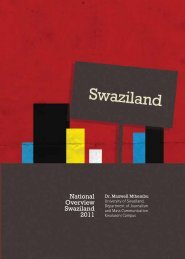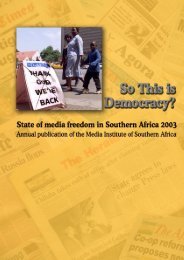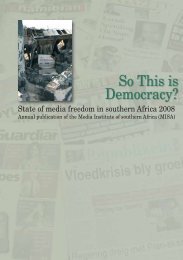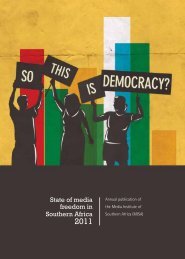Twenty years after the Windhoek Declaration on press freedom
Twenty years after the Windhoek Declaration on press freedom
Twenty years after the Windhoek Declaration on press freedom
Create successful ePaper yourself
Turn your PDF publications into a flip-book with our unique Google optimized e-Paper software.
ability Index” (MSI). In <str<strong>on</strong>g>the</str<strong>on</strong>g> past four<br />
<str<strong>on</strong>g>years</str<strong>on</strong>g> of <str<strong>on</strong>g>the</str<strong>on</strong>g> MSI has tracked media<br />
development in 40 sub-Saharan African<br />
countries. The study applies<br />
five objectives to define sustainability,<br />
each objective being measured<br />
by indicators like promoti<strong>on</strong> and<br />
protecti<strong>on</strong> of free speech; professi<strong>on</strong>al<br />
journalism; plurality of news<br />
sources; business management; and<br />
supporting in-stituti<strong>on</strong>s. The criteria<br />
are used to reflect a socially effective<br />
and ec<strong>on</strong>omically sound media<br />
sector.<br />
The results of <str<strong>on</strong>g>the</str<strong>on</strong>g> MSI 2006/7<br />
indicated that media in South<br />
Africa was sustainable. However,<br />
since 2008 no sub-Saharan African<br />
country has obtained a sustainable<br />
rating. South Africa still leads with<br />
“near sustainable” rating.<br />
Of <str<strong>on</strong>g>the</str<strong>on</strong>g> 40 countries measured in<br />
this study, 15 are in <str<strong>on</strong>g>the</str<strong>on</strong>g> lower levels<br />
of “near sustainable”, 20 in <str<strong>on</strong>g>the</str<strong>on</strong>g><br />
unsustainable mixed system, and<br />
at least 14 nearing sustainability.<br />
Eritrea and Equatorial Guinea are<br />
<str<strong>on</strong>g>the</str<strong>on</strong>g> <strong>on</strong>ly two in <str<strong>on</strong>g>the</str<strong>on</strong>g> unsustainable<br />
and anti-free <strong>press</strong> category. These<br />
are an indicati<strong>on</strong> of <str<strong>on</strong>g>the</str<strong>on</strong>g> movement<br />
in media development in sub-<br />
Saharan Africa, and <str<strong>on</strong>g>the</str<strong>on</strong>g>y show<br />
that sub-Saharan Africa’s media<br />
envir<strong>on</strong>ment has regressed.<br />
Ratings for Botswana went below<br />
sustainable partly due to <str<strong>on</strong>g>the</str<strong>on</strong>g> introducti<strong>on</strong><br />
of <str<strong>on</strong>g>the</str<strong>on</strong>g> Media Practiti<strong>on</strong>ers<br />
Act in December 2008. Restricti<strong>on</strong>s<br />
in legislative bills in South Africa<br />
and proposed changes to <str<strong>on</strong>g>the</str<strong>on</strong>g> selfregulatory<br />
system of <str<strong>on</strong>g>the</str<strong>on</strong>g> print media<br />
will have a negative impact <strong>on</strong> <strong>press</strong><br />
<strong>freedom</strong> and access to informati<strong>on</strong>,<br />
and <str<strong>on</strong>g>the</str<strong>on</strong>g>refore sus-tainability.<br />
From a media business perspective<br />
of <str<strong>on</strong>g>the</str<strong>on</strong>g> five objectives, two are especially<br />
relevant for this article: <str<strong>on</strong>g>the</str<strong>on</strong>g><br />
scores for professi<strong>on</strong>al journalism<br />
and business management. The indicators<br />
for <str<strong>on</strong>g>the</str<strong>on</strong>g> first of <str<strong>on</strong>g>the</str<strong>on</strong>g>se includes:<br />
ethical and well sourced reporting,<br />
payment scales and availability of<br />
102 | Media in Africa - 2011<br />
efficient equipment and quality<br />
niche reporting. The business management<br />
objective includes revenue<br />
generati<strong>on</strong> from multiple sources,<br />
availability of credible market research<br />
and percentages in ad spend.<br />
“Restricti<strong>on</strong>s in<br />
legislative bills in<br />
South Africa and<br />
proposed changes to<br />
<str<strong>on</strong>g>the</str<strong>on</strong>g> self-regulatory<br />
system of <str<strong>on</strong>g>the</str<strong>on</strong>g> print<br />
media will have a<br />
negative impact <strong>on</strong><br />
<strong>press</strong> <strong>freedom</strong> and<br />
access to informati<strong>on</strong>,<br />
and <str<strong>on</strong>g>the</str<strong>on</strong>g>refore<br />
sustainability.”<br />
The two can be understood in relati<strong>on</strong><br />
to Phillip Meyer’s “influence<br />
model” in regard to newspaper businesses.<br />
He notes that an abundance<br />
of informati<strong>on</strong> gives readers greater<br />
choice and makes it harder to find<br />
a loyal audience. The credibility of<br />
c<strong>on</strong>tent becomes ever more critical<br />
in this scenario.<br />
The influence model according<br />
to Meyer shows that credibility<br />
has an influence <strong>on</strong> profitability.<br />
Likewise, <str<strong>on</strong>g>the</str<strong>on</strong>g> MSI objectives dealing<br />
with professi<strong>on</strong>al journalism and<br />
business management show that<br />
<str<strong>on</strong>g>the</str<strong>on</strong>g>re is a correlati<strong>on</strong> of low scores<br />
in each area.<br />
Meyer posits that if a media outlet<br />
is credible especially with its immediate<br />
community, it is bound to be<br />
financially viable, because quality<br />
c<strong>on</strong>tent ultimately attracts audiences.<br />
Effectively, <str<strong>on</strong>g>the</str<strong>on</strong>g>n, advertisers,<br />
investors and funders are not <str<strong>on</strong>g>the</str<strong>on</strong>g><br />
<strong>on</strong>ly determiners of financial viabili-<br />
ty and future sustainability. Instead,<br />
media sustainability will benefit<br />
from a reas<strong>on</strong>able investment into<br />
quality c<strong>on</strong>tent.<br />
REFERENCES:<br />
Meyer, P. 2004. The Influence<br />
Model and Newspaper Business;<br />
Newspaper Research Journal, Vol<br />
(25) 1, 66-83, winter 2004.<br />
Mavhungu, J. O’Shea, C. 2009.<br />
Formative Target Audience<br />
Research: A Case Study of Five<br />
Community Radio Stati<strong>on</strong>s in South<br />
Africa. Grahamstown: Sol Plaatje<br />
Institute for Media Leadership.<br />
Milne, C., Rau, A., Du Toit, P.,<br />
Mdl<strong>on</strong>gwa, F. 2006. Key Editorial<br />
and Business Strategies: A case<br />
study of six independent community<br />
newspapers. Grahamstown:<br />
Sol Plaatje Institute for Media<br />
Leadership.












